Stereoscopic microscopes belong to a wide class of equipment that enables the user to perform a wide variety of tasks. Simply put, a stereomicroscope is a special device that allows you to see in more detail and distinctly volumetric objects magnified several times, and to study biological samples when they are examined in detail.
As a rule, such devices are used in cases where there is a need for a so-called volumetric increase of the object under study, while maintaining clarity, high contrast levels, and depth of field. Often this equipment is used when performing a variety of restoration work, while gluing or soldering small objects. The editors of the site "bestx.htgetrid.com/en/" have prepared for your attention, taking into account the reviews, advice and recommendations of the majority of users, a rating of the best stereomicroscopes as of 2020.
Content
Equipment description
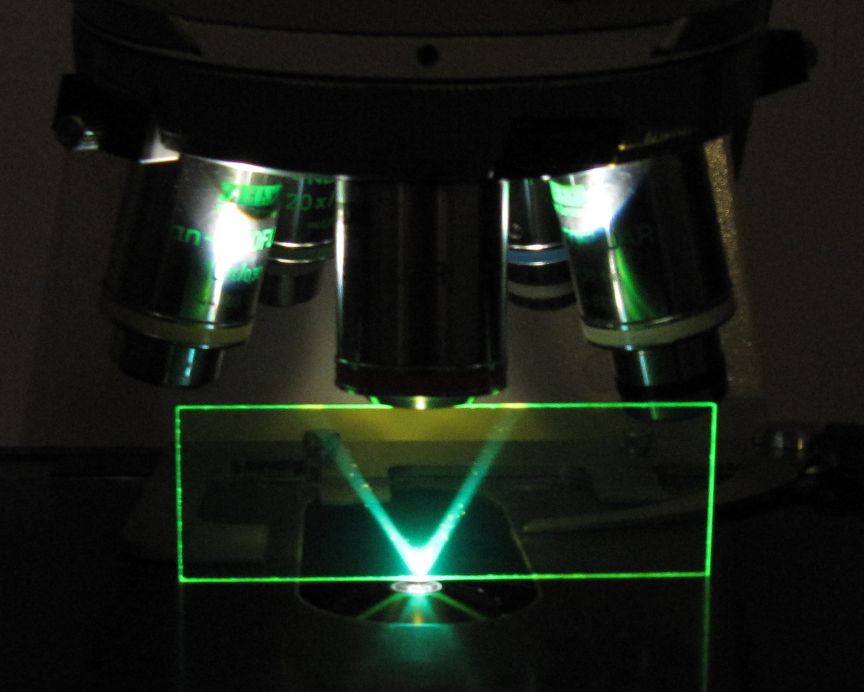
Stereoscopic microscopes are optical devices that allow observation and study of various objects not in a flat, but in the so-called volumetric range. They can be digital or analog. When an object is enlarged, its image forms a stereo pair. Due to this, the image of the object in question is transmitted separately. This allows you to more accurately determine the shape, study the structure, as well as the size of various micro-objects.
Digital devices are equipped with a special high-resolution video camera, which is installed at an angle of 48.5 degrees in relation to the material under study, as well as a lens. The formation of a stereo image occurs due to the rotation of the lens in the horizontal plane in relation to the object under study. The resulting picture directly from the camcorder can be transferred to the monitor and recorded.
In addition, such devices are equipped with a backlight. After all, work with such a microscope is usually carried out in reflected light. The illuminators are usually mounted on the surface of the body and can be rotated when it becomes necessary to change the lighting angles.
Stereoscopic microscopes are additionally equipped with object tables on which the studied samples are placed. Such a table can be moved at the request of the user with respect to the horizontal plane.
What types are there
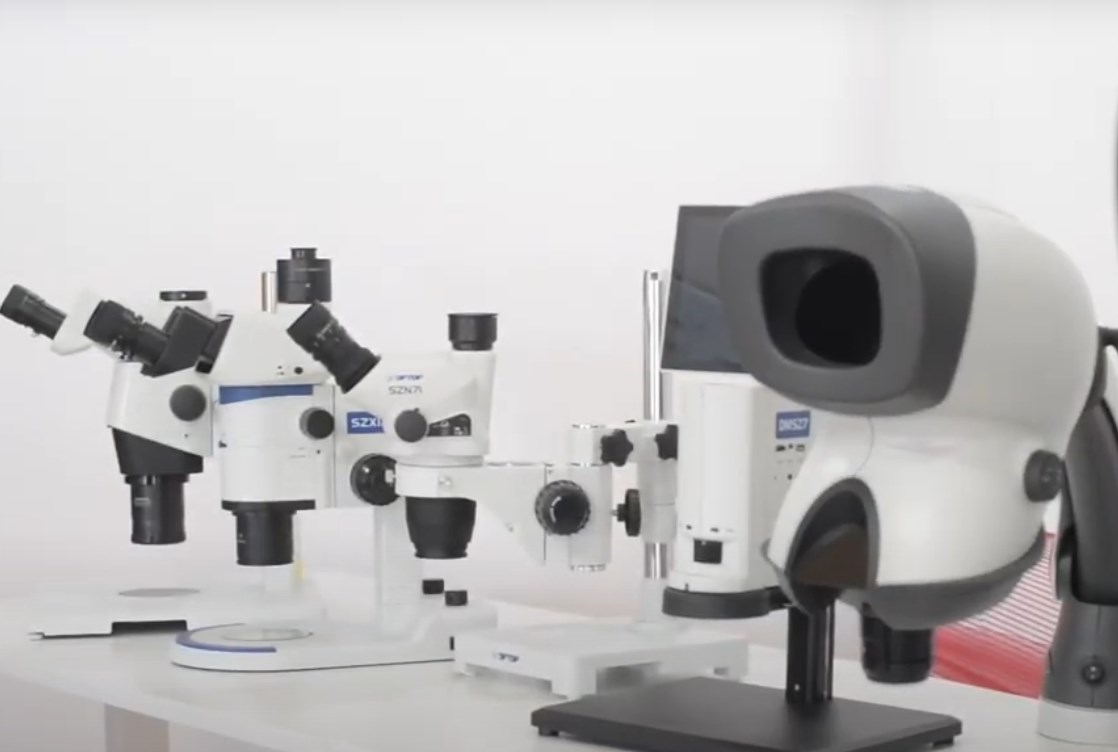
What to look for when choosing? At the moment, stereomicroscopes, according to their structure, are of two types. They work according to the Grenoux or Abbe scheme (which is a parallel scheme in which only one main lens is used). It should be noted that each scheme has both its own specific advantages and some disadvantages. As a rule, both Grenoux and Abbe microscopes are used with the same frequency in a variety of institutions.However, it should be noted that devices operating using the Greenoux circuit are slightly cheaper compared to analogs using parallel systems.
The image on devices operating according to the Greenough scheme is formed due to two separate optical paths, which diverge at the stereoscopic angle. Their essential disadvantage is that the optical axis of the objective is tilted with respect to the material under study. The result is a trapezoidal picture. The human eye compensates for this effect, however, with prolonged use of such a microscope, the user will feel tired. In addition, such equipment has slight discrepancies in the ratio of focus and magnification, which also creates a slight discomfort for the user during the observation.
The main advantage of devices working on the Grenoux scheme is that they provide good depth and sharpness of the picture. They have a high level of stereoscopicity, are compact devices that do not take up much space in the workplace.
Devices operating according to the Abbe scheme are equipped with only one objective, which is located in a perpendicular plane with respect to the material under study. At the same time, due to the diameter of the lens, the stereoscopic angle, when working with such equipment, has certain limitations (up to 11 degrees).
Devices operating according to such a scheme have a large field of view and exclude the possibility of various distortions in the picture obtained during the study of various samples. In more modern models of stereoscopic microscopes, Plan Apochromatic objectives are used, which provide high quality images in the eyepiece and on the camera.
On a note! Stereomicroscopes operating on the Abbe scheme have a more complex design, require a higher correction of the lens aberration, therefore, they are more expensive than analogs operating on the Greenough scheme. As a rule, the Abbe scheme is used to create stereoscopic microscopes that belong to the laboratory or research class.
Distinctive features and benefits
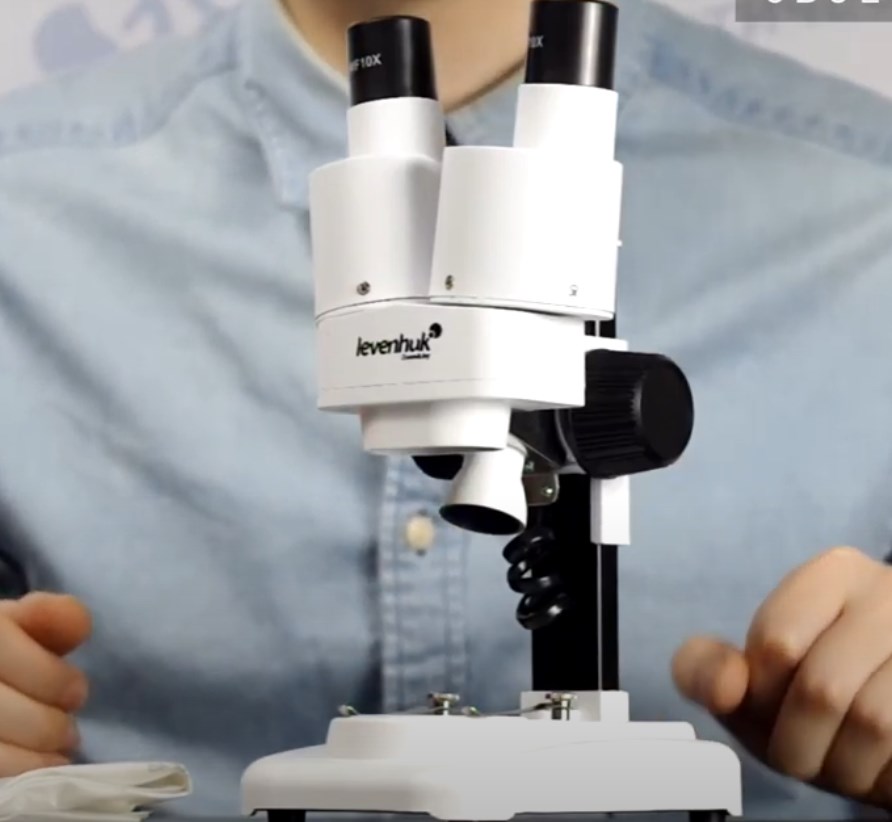
Stereomicroscopes, in comparison with other types of microscopes, have some differences and features. Such equipment is capable of:
- Form volumetric 3D images;
- Show a straight, not upside-down picture;
- Form a great depth of field;
- Show objects at a long focal length.
However, stereoscopic microscopes have a low magnification. The image obtained with simple microscopes becomes flat. With the help of stereomicroscopes, the user, thanks to the work of a stereopair, can obtain three-dimensional images of various objects. The working distance of work on such equipment, directly from the surface of the lens to the object under study, is no more than 40 cm. This greatly simplifies the manipulation when working with large, dimensional samples.
The working magnification of ordinary microscopes is no more than 1500 - 2000 times. Stereoscopic models have a low working magnification. Therefore, such equipment is used when studying large material. The scope of such devices can be varied. They are often used in medicine, botany, zoology, mineralogy. Such equipment is indispensable in jewelry, microelectronics, as well as in carrying out a variety of forensic examinations.
Scheme selection
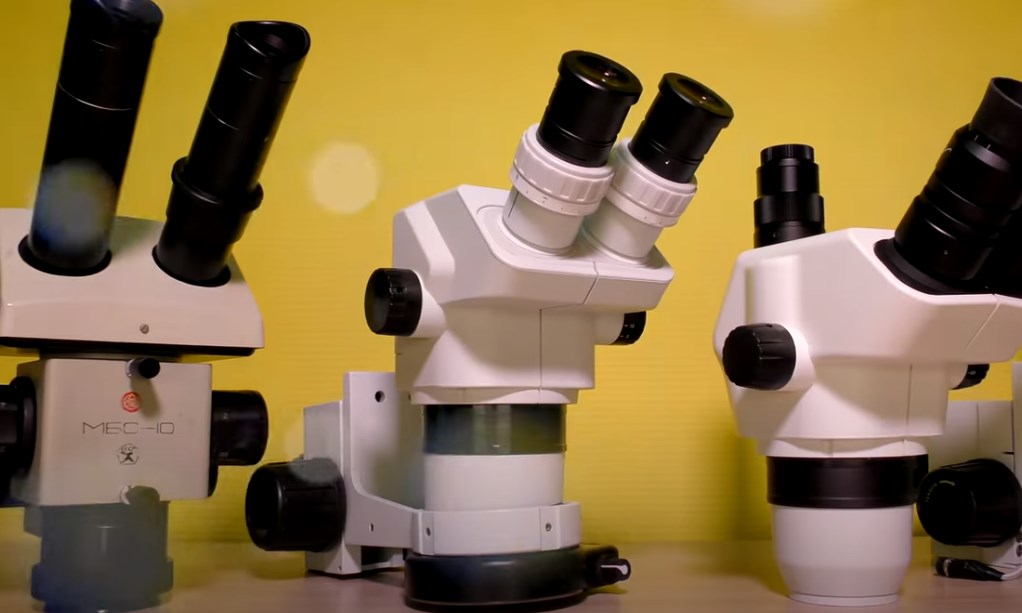
How to choose a stereomicroscope, what are the selection criteria, which one is better to buy? Choosing a stereoscopic microscope scheme is necessary, first of all, taking into account the needs of the user and the type of tasks performed. Some people mistakenly believe that Abbe devices are the best option for any use and application.
It should be noted that devices operating on the Grenoux diagram are perfect for performing a variety of restoration work, during soldering, when positioning crystals, and so on. They are the most optimal solution when tasks do not require high magnification (up to 100x), when working at long working distances (no more than 100 mm).
Important! It is difficult to obtain high-quality photographic images without geometric errors on models working according to the Greenough scheme. This is due to the fact that the lens in relation to the studied material is in an inclined position.
To obtain good quality photomicrographs with high, sharp resolution, or when working with subjects where magnification plays a primary role, it is recommended to use devices equipped with a main common lens. To obtain photographs, display the high-definition image obtained from the microscope on projectors or monitors for demonstration purposes, it is recommended to purchase stereoscopic microscopes on the Abbe scheme.
The best stereo microscopes for 2020 and their capabilities
Modern models of stereomicroscopes have an improved functional design and a high level of ergonomics. Such equipment is additionally equipped with special switches of the optical path directly between the camera and the eyepiece. This greatly simplifies the process of registration and fixation of the resulting images in digital format. When choosing such a device, you should pay attention to:
- Zoom parameters, zoom range, and object field;
- Depth of field and numerical aperture index;
- Ergonomics level;
- Lighting quality;
- The optics of the apparatus and the indicator of its working distance.
Which company is the best stereomicroscope? The world's leading manufacturers of stereomicroscopes are companies such as Leica and Nikon. Popular models of these top manufacturers have high accuracy parameters, and are also equipped with a special port that allows you to additionally connect digital cameras to them. In addition, in the case of using special lenses, as well as eyepieces, the user using such equipment can magnify the samples under study up to 300 times.
What is the best stereo microscope, where can you buy it? Devices of Japanese and Russian production are very popular, in which such parameters as price and quality of performance are optimally combined. For small school laboratories, for a child and small children, most users purchase Chinese children's models.
These Chinese-made microscopes have good functionality, are suitable for viewing large objects and are relatively inexpensive. You can buy such equipment in the Ali Express online store by making an online order.
Review of the best models of Greenough stereomicroscopes
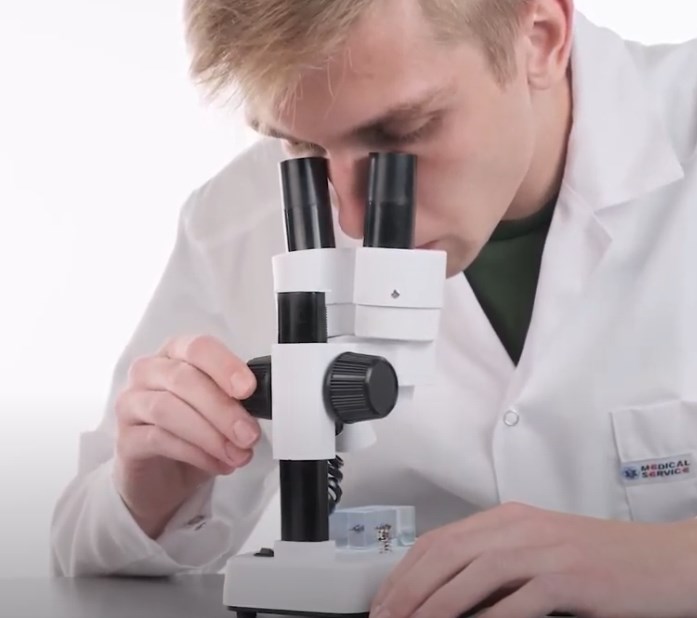
Devices operating according to the Grenoux system have a high resolution, as well as the so-called depth of sharp vision. Thanks to this, with a focused stereomicroscope system, the user receives clear, high-quality images. The Grenoux system works thanks to two optical branches that create a stereoscopic angle.
Micromed MS - 1 version 1A (2x / 4x)
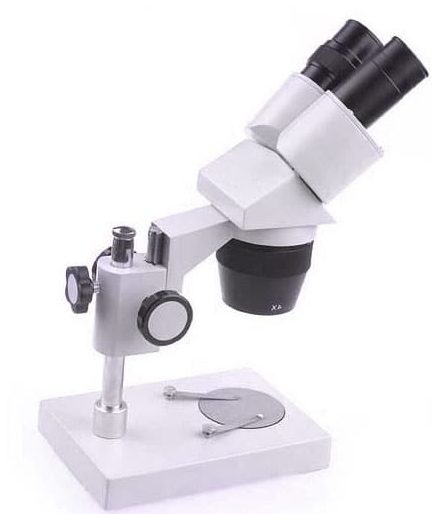
High-quality, reliable, budget model, which is suitable for studying materials in reflection, as well as in transmission Suitable for performing complex, delicate work that requires an increase in the working surface of the object under study. The optical scheme of Grenoux in combination with an antireflection coating ensures high quality of the resulting image with a distinct depth of field, as well as stable contrast throughout the entire field of view.
In addition, thanks to the use of this device, it is possible to obtain the most accurate level of color rendering of the material under study under multiple magnification.Equipped with precise and smooth focusing mechanism. Thanks to this, the user does not need to make great efforts to adjust the level of sharpness obtained when magnifying objects in the picture. Supports diopter correction.
The magnification on this device is 20x / 40x. The visual attachment has an angle of 45 degrees. The revolving device rotates 180 degrees. The interpupillary distance can be adjusted in the region of 55-75 mm. A binocular attachment is used for the operation of this apparatus.
Advantages:
- Small dimensions (weight 2.5 kg);
- Ease of use;
- Build quality;
- The presence of diopter correction;
- Low cost (10,600 rubles);
- You can connect a video eyepiece through an adapter.
Disadvantages:
- The basic configuration does not provide for the presence of lighting equipment (you will have to purchase it separately).
LOMO SME - 1 option 22
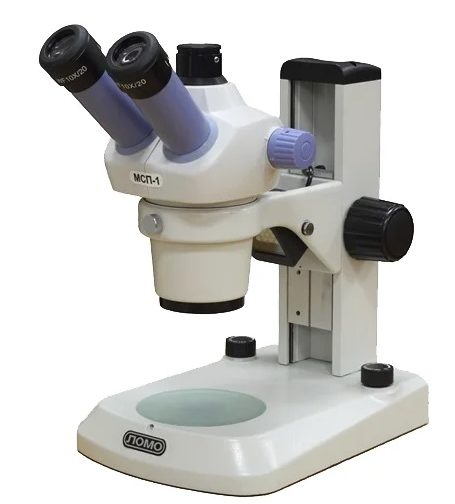
The MSP-1 model is equipped with a high-quality optical head mounted on a tripod. It should be noted that the tripod is additionally equipped with a special focusing mechanism with the possibility of using replaceable cards. This model of a stereoscopic microscope is equipped with a special illumination system that works with transmitted light rays or with light that is reflected from an inclined illumination device. Thanks to such an illumination system, the user with the help of MRP -1 can observe and get a clear picture even when viewing a variety of objects with different characteristics (suitable for studying translucent, transparent or opaque samples).
The type of attachment used on this microscope model is a trinocular. For lighting, LED backlighting is used. The tilt angle of the eyepiece is 45 degrees. The magnification ranges from 10 to 90 x. The backlight is located at the bottom of the device. It has the possibility of diopter adjustment, as well as adjustment of the interpupillary distance. The working distance is 97 mm. The body of this device is made of metal and plastic.
Advantages:
- Large area of application (can be used in research in the field of archeology, biology, veterinary medicine, geology);
- Suitable for use in industries such as microelectronics, watchmaking and jewelry;
- Complete with wide-field eyepieces (10x and 20x);
- Equipped with a special C-mount adapter (you can connect a video camera or photo camera to this device);
- The quality of the resulting image;
- The presence of the "zoom" system (from 1 to 4.5x).
Disadvantages:
- High cost (the price of this device is 54,000 rubles);
- Equipped with only one, bottom illumination, which is not always convenient when studying volumetric objects;
- Mains powered;
- Large weight (6 kg).
Micromed MS -2 - ZOOM DIGITAL
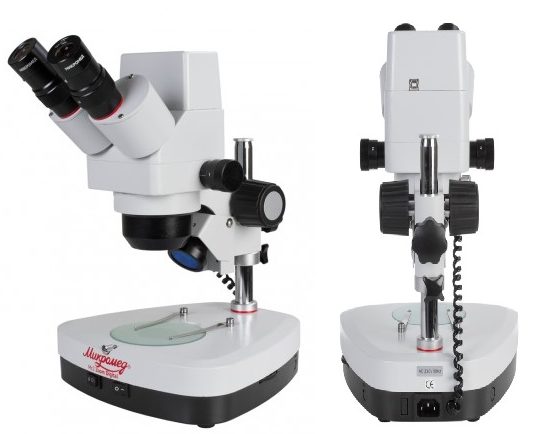
This Chinese-made model is perfect for observing, displaying both volumetric samples and small, thin transparent or film objects on a computer screen. In addition, this device is suitable for performing various so-called delicate manipulations with the material under study (preparation, technological operations).
Both natural and artificial lighting are used for research. At the base of this device, special illuminators are built in, which are able to use the reflected and transmitted light flux with the possibility of self-regulation of its intensity.
Besides, MC-2 - ZOOM DIGITAL is equipped with a special dark-field mechanism and tweezers. Thanks to this, the user can conduct a variety of gemological studies. In case of changes in the magnification parameters of the test sample or when changing the eyepieces, the working distance parameter remains unchanged. The working distance in this model is 85 mm. However, in the case of using special attachments, the user himself can change the working distance (up to 172 mm), or reduce it (no more than 28 mm).
The general parameters of the magnification range of this model of a stereoscopic microscope is 2.5 - 160 times (when using additional equipment). The basic equipment of this device has a magnification range of 10-40 times. Additionally it is equipped with a built-in video camera (1.3 Mpix), which allows displaying the resulting image on a personal computer monitor.
Advantages:
- Equipped with a pancratic lens (the ability to smoothly change the magnification parameters without loss of image quality and clarity is provided);
- Built-in camera;
- Has a high depth of field, excellent contrast throughout the field of view;
- High level of color rendering;
- 12 months warranty;
- Smooth and precise focusing mechanism;
- The modular design allows you to independently select the configuration of this device;
- Equipment.
Disadvantages:
- High cost (40,180 rubles);
- The basic configuration provides a small magnification range (no more than 40x).
Overview of the highest quality devices of the Abbe system

Stereoscopic microscopes operating thanks to the Abbe system are able to carry out their work at small working distances, but at a much larger, so-called linear field. Such a system has two luminous fluxes running parallel to each other, but formed by just one lens. These devices are best suited for applications requiring visual analysis of a variety of samples. When using them, you can get a more accurate result in the case of a variety of measurements.
LEVENHUK D320L PLUS
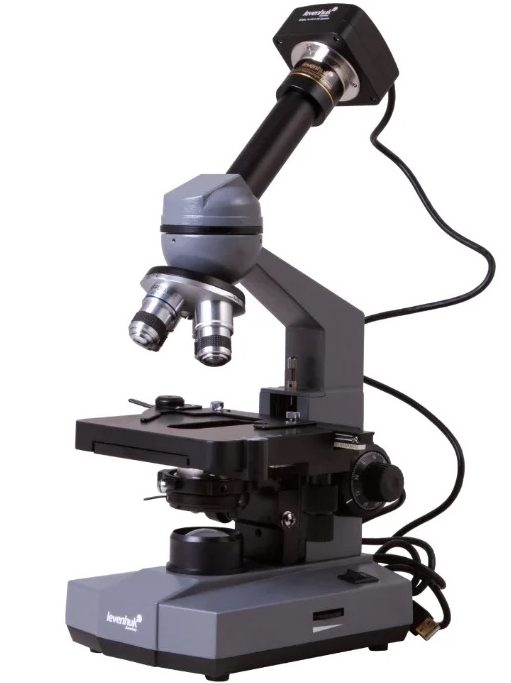
The LEVENHUK D320L PLUS stereomicroscope is a laboratory model that is perfect for professional observation of objects. Suitable for studies of hematological, morphological, biochemical types. Devices of this type can be equipped with laboratories in a variety of medical and research institutions. In addition, this device can be used to train students in a variety of narrowly specialized specialties.
This model is equipped with achromatic optics, due to which a clear, contrasting and highly detailed picture is obtained, in which there are no various optical distortions and defects. Complete eyepieces, due to which a flat and wide field of image perception is created, allow the analysis of extended objects with a complex structure. The monocular attachment in this model rotates 360 degrees. The magnification level is from 40 to 1600 times.
For reliable fixation of micropreparations, a special stage is used, which the user can move in two directions. Sharpness adjustment is carried out thanks to the work of the coaxial mechanism, which can perform both fine and coarse focusing. To illuminate the samples under study, a special LED backlight is used, equipped with an option to adjust the brightness level. The light beam passes directly through the Abbe capacitor. In this case, the intensity level of the light beam can be independently adjusted using the iris diaphragm.
The LEVENHUK D320L PLUS stereomicroscope belongs to the biological type equipment. The type of attachment used is a monocular. Designed for laboratory research. Equipped with a rotary attachment with a tilt angle of 30 degrees and a special revolving device with 4 lenses.
Advantages:
- Affordable price (average cost is 21331 rubles);
- The presence of a rotary monocular nozzle;
- Equipped with achromatic wide-angle optics;
- 0.75 W LED backlight with self-dimming capability;
- Batteries (3AA) or mains can be used as a power source;
- Operating time from autonomous power sources (batteries is about 10 hours);
- Equipment;
- Made from quality materials.
Disadvantages:
- Suitable for laboratory research only;
- Difficult to set up.
BRESSER 52-01000
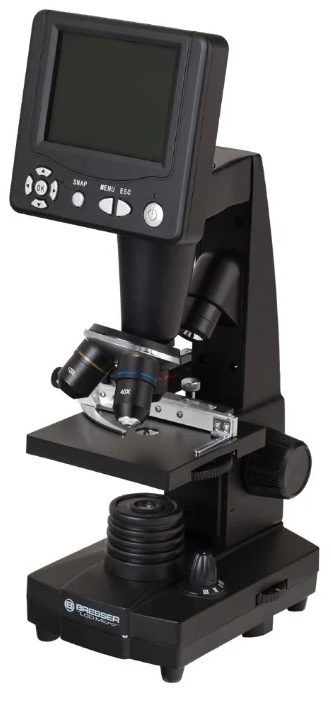
A reliable, high-quality, according to buyers, laboratory-type digital stereo microscope that supports connection to other devices via the USB port. Perfect for exploring both large and small objects. Equipped with a combined illumination system (upper and lower), thanks to which this device can get a clear image of volumetric objects with a complex structure. This model uses an LED type backlight.
In addition, BRESSER 52-01000 is equipped with a revolving device that houses 3 lenses. The magnification range of objects is 50-2000. In addition, when studying various materials, if necessary, the user can independently adjust the brightness level of the backlight.
It should also be noted that BRESSER 52-01000 is equipped with a 5 Mpix video camera, which allows you to record video of the material being studied. This device can be powered either from the mains or via the USB port. The delivery set includes three lenses (4x, 40x, 10x). It can work with both Windows 7,8,10 and Vista OS.
Advantages:
- Good build quality
- Detailing images;
- The presence of a combined lighting system;
- Equipped with light filters;
- Suitable for studying small objects;
- The adjusting screws are smooth running;
- Backlight brightness level adjustment;
- Acceptable cost for such a model of a stereoscopic microscope (32,486 rubles).
Disadvantages:
- Does not come with a memory card;
- Some users claim that there is no 2000x magnification as claimed by the manufacturer;
- When objects are enlarged more than 1000 times, the image quality is slightly reduced.
Armed XSZ - 107
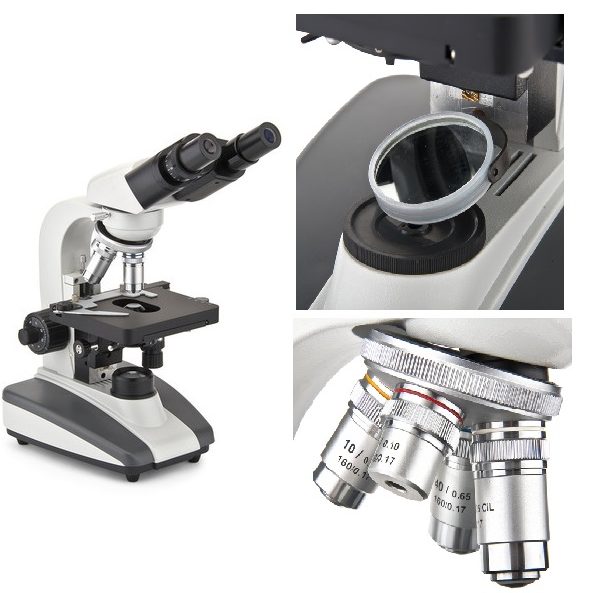
This reliable, high quality laboratory microscope is used for research as well as observation of biological samples. Used in research medical institutions, suitable for a variety of demonstrations for the purpose of teaching, conducting bacterioscopy.
The Armed XSZ - 107 construction consists of several components. This model is equipped with a stand, a sturdy tripod, a tuning knob, a revolver, an eyepiece head, a stage, a wide-view eyepiece and an Abbe condenser. It should be noted that the Abbe condenser is equipped with a so-called iris diaphragm.
A halogen lamp is used as an illuminator. The maximum and minimum magnification is 10x. The eyepieces can be rotated 360 degrees. Equipped with lenses with a zoom range of 4x, 10x, 40x, 100x. With this device, you can use a monocular as well as a binocular head (tilt angle is 30 degrees).
Advantages:
- Build quality;
- Ease of operation and technical characteristics;
- The ability to adjust the brightness level;
- Functional;
- Possibility to install four lenses;
- The ability to tilt the device up to 30 degrees;
- Precise and easy focus adjustment;
- Acceptable cost (22,425 rubles);
- If necessary, the light bulb can be exchanged for a mirror.
Disadvantages:
- As a backlight, not an LED, but a halogen lamp is used, which is why. With prolonged use, eyes get tired;
- Some users point to poor tripod quality.
Comparative table of stereomicroscopes models
| Name, description | Scheme type | Magnification (times) | Cost, rub.) |
|---|---|---|---|
| Micromed MS - 1 version 1A (2x / 4x) | Grenou | 20x / 40x | 10600 |
| LOMO SME - 1 option 22 | Grenou | 10-90x | 54000 |
| Micromed MS -2 - ZOOM DIGITAL | Grenou | General (2.5-160) With basic configuration (10-40) | 40180 |
| LEVENHUK D320L PLUS | Abbe | 40-1600 | 21331 |
| BRESSER 52-01000 | Abbe | 50-2000x | 32486 |
| Armed XSZ - 107 | Abbe | 10x | 22425 |
Stereomicroscopes are special devices that allow viewing objects or objects in volumetric perception. Such devices are of two types - operating on the Grenoux circuit or the Abbe circuit.
How to choose the right stereo microscope, what mistakes to avoid when choosing? The choice of a stereomicroscope should be based primarily on the needs and tasks set for the user. For work related to the restoration of objects, soldering microcircuits, and so on, it is preferable to use devices that work on the Grenoux circuit.
Stereomicroscopes operating on the Abbe scheme are best suited for taking pictures and micrographs of an object enlarged several times. If in everyday life you use a stereomicroscope, which is presented in our rating, or use a different model of such equipment, please share your experience and opinion with us in the comments.












